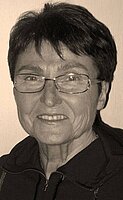Hon.Prof. Dr.-Ing. Eveline Gottzein
Developed and lead the Control and Simulation Department of the Space Division of MBB GmbH, now Astrium GmbH.
Developed and lead the Control and Simulation Department of the Space Division of MBB GmbH, now Astrium GmbH.
In this position, she established the engineering process for Attitude and Orbit Control System (AOCS) development and qualification. She also developed the organization, to cover system-, hardware- and software-design and development for AOCS of spacecraft and Magnetic Levitation and Guidance systems for high speed trains. A major part concerned the concept and development of associated simulation and test facilities for closed loop end to end simulation and testing of AOCS with as much hardware in the loop as possible. The facilities were also used for testing of operational procedures, and training of personal for satellite launch and operation. This concept, applied to all MBB communication satellites, was so successful, that the process and facilities are still in use to-day, resulting in an accumulation of over 600 years of successful orbital operation with no loss of spacecraft attributed to AOCS failure.
The process was first used for the development of the Intelsat 5 AOCS (MBB was here subcontractor to FACC, Ford Aerospace and Communications Company). Part of it was the development of three-axis-motion simulators for sub-arc-seconds pointing requirements and high angular and dynamic range, based on in-house developed hydraulic actuators. These motion simulators later became a MBB product line.
For the TV- Sat series of satellites (TV-Sat1&2; TDF1&2; Tele-X) Dr. Gottzein directed the transition from analog to digital implementation of AOCS. The TV-Sat satellites were three axis-stabilized in all AOCS modes, including for the first time three-axis-stabilized transfer orbit mode and apogee boost mode. She personally contributed to the design of the Intelsat 5 and TV-Sat station keeping controllers, which were designed in particular to cope with weakly damped structural modes under discontinuous control intervention Patent-Nr.46151, issued 21.11.1985).
Parallel to the engagement in Satellite AOCS, Dr. Gottzein personally advanced design, development and testing of levitation and guidance systems for MagLev (magnetically levitated) high speed trains, covering new grounds and building, with her department, systems from scratch, which had not been done before. This included system modeling and simulation, hardware and software development including magnet current drivers, integration and high speed tests.
In 1971, the first passenger carrying MagLev vehicle, named “MAGNETMOBILE” levitated by electromagnets and propelled by linear induction motor carried 8 to 12 passengers at a sustained speed of 108 km/h. Characteristics of the levitation and guidance control systems were contour and platform modes. The transition frequency between the two modes was adjusted to optimize ride comfort and power consumption (Patents No. 2127047, issued 27.03.1975 and No. 3117971, issued 05.12.1983). The concept reflected experience from the development of the low altitude control system of the see skimmer missile Kormoran, where Dr. Gottzein was personally involved.
In 1975, the “Komponentenmeßträger (KOMET)” for high speed testing of MagLev systems and components reached a top speed of over 400 km/h. The success was based on Lab tests, which Dr. Gottzein initiated, to optimize the arrangement of the magnets for high speed rides, using rotating aluminum wheels which were equipped with different steel hoops.
In 1979, the first full scale operational MagLev vehicle, TRANSRAPID 05, was put into operation at the International Transportation Exhibition in Hamburg. The levitation and guidance systems of this vehicle are based on the “Magnet Wheel Concept”, This concept was first developed by Dr. Gottzein in her doctor´s thesis, and became the basis for all later German high speed MagLev vehicles, in particular the first full scale high speed vehicle TRANSRAPID 06. In 1984, the TRANSRAPID 06 reached the specified design speed of over 400km/h on the 31,5 km closed loop test track of the TRANSRAPID Versuchsanlage im Emsland (TVE), Germany.
The “Magnet wheel Concept” (Patent No. 2511382, issued 23.03.83) is characterized by hierarchy and decentralization down to autonomous basic modules on the first level to support a high degree of functional redundancy. This key feature guaranties vehicle safety at all speeds: One out of eight basic levitation and guidance modules might fail without performance degradation of the Maglev System. The basic modules consist of the magnets, which are individually attached by springs and dampers to Magnet Frames or Boogies, and carry the sensors (gap and acceleration sensors), and the electrical and electronic unit, consisting of single magnet controllers, magnet current drivers, and command and telemetry interfaces. Each cabin is supported by four magnet frames through secondary suspension, each magnet frame is carried by 4 levitation and guidance magnets on each side.
Since 1993, in her position as Scientific Consultant to EADS Astrium GmbH, she initiated the development of a GPS receiver, strictly tailored to commercial spacecraft applications. The single board L1-receiver is based on software correlation, and for use either integrated into the Avionic system or as a stand- alone receiver. The receiver is now a very successful product of EADS Astrium GmbH.
She also initiated the development of a novel attitude, rate and position sensor based on advanced image processing using Active Pixel (APS) detector technology. A functional model of the sensor was flight tested to prove the concept with promising results in low Earth orbit. The sensor and results of the flight tests were presented at the “4th ESA Round Table on Micro/Nano Technologies for Space”, 20-22 May, 2003.
She is presently involved in the development of a next generation Multi-Frequency GNSS (GALILEO) receiver, extension of GNSS range of applications e.g. to launch vehicles and to GEO satellites.



